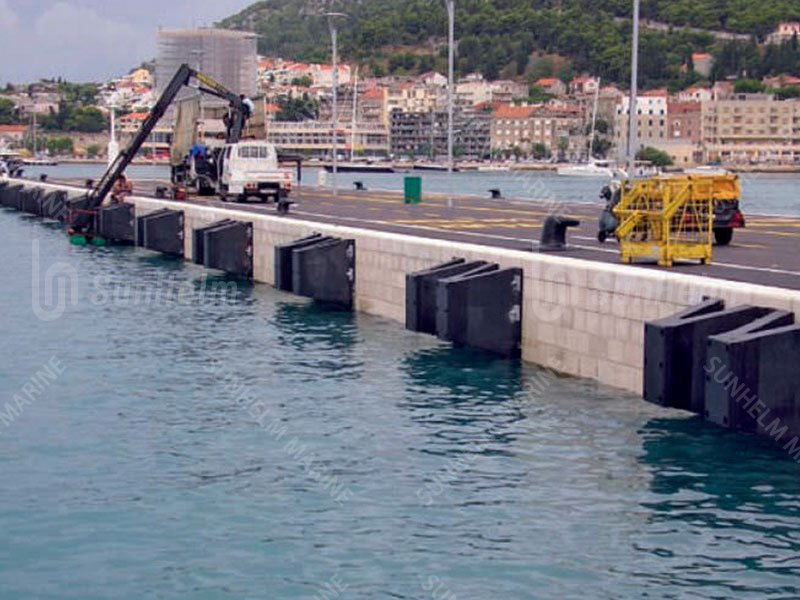Why Calculating Arch Fender Size Is Necessary—And Urgent
When your vessel gently slides into the berth, you rarely think about the hidden heroes: marine fenders. But if those fenders are undersized, your hull could scrape, dent, or worse—while oversized fenders can slip or hit the water inefficiently. I’ve seen a 30‑ft pleasure yacht with undersized arch fenders bounce off its mooring bollard, damaging a fresh coat of paint. The cost? More than just cosmetic. Calculating the right arch fender size isn’t just about saving money—it’s about preserving your vessel’s integrity and safety in changing tides and weather.

Featured Snippet: How to Calculate Arch Fender Size
Determine arch fender size by using your vessel’s berthing energy, hull curvature, and bollard pull. Use PIANC guidelines to convert energy into fender width, height, and deflection specs—and ensure the arch compresses evenly against your hull’s radius. Transitioning from general sizing norms to Sunhelm’s precise specs guarantees optimal protection.

Step‑by‑Step: Sunhelm’s Arch Fender Sizing
- Calculate Berthing Energy
Berthing energy equals ½ × mass × velocity². This figure tells you how much impact a fender must absorb per docking event. - Match Berthing Energy to Arch Profile
Use Sunhelm PIANC-compliant arch fender charts (based on type and size) to select a model that can absorb that energy while maintaining low reaction force. - Check Hull Curvature & Fender Width
The arch width must align with the vessel’s radius so that it fully contacts the hull, spreading the load evenly. Too narrow, and it skews under pressure. - Verify Deflection Range
Arch fender compress and flex. Confirm your chosen width and height, allow 30–55% deformation without bottoming out. - Finalize Wheelbase (W1/W2)
The install distance (W1 & W2) supports load distribution. Refer to Sunhelm’s technical charts, ensuring it handles your vessel’s mass per W‑spacing guidelines.
Why This Matters Now
- Regulatory Compliance: Most ports require PIANC-certified fenders like Sunhelm’s.
- Safety in Rough Conditions: Rising storms and tidal surges stress undersized fenders.
- Cost Efficiency: Choosing the wrong means extra paint damage, fender replacements, or downtime.
Stick around—you’ll learn how to pick the right model, save maintenance time, and future‑proof against harsher conditions.
FAQs
Q: What are arch fenders used for?
A: Arch fenders are extruded, arch-shaped rubber fenders that absorb impact by compressing under vessels. They offer high-energy absorption with low reaction force, ideal for small to medium ports.
Q: What’s the difference between arch fenders and V‑fenders?
A: Unlike V‑fenders, arch fenders have a curved, arch design that evenly spreads loads. They deliver better energy absorption with softer reaction—ideal for vessels with curved hulls.
Q: How do I measure hull curvature for fender width?
A: Measure the radius of curvature along the berthing section, then ensure the arch width matches that curve for uniform load distribution—refer to Sunhelm’s width tables for exact sizing.
Q: Can I use arch fenders for large ships?
A: Yes—Sunhelm’s arch fender range supports vessels from small yachts to cargo vessels. Their PIANC-compliant models and charts let you scale up using the same sizing method.
Q: Are arch fenders right for rough tidal ranges?
A: Yes—arch fenders compress and maintain contact across tide changes. Plus, Sunhelm offers models with UHMW‑PE faces for enhanced wear resistance.
Final Thoughts
Correct arch fender sizing with Sunhelm keeps your boat safe, docks intact, and your wallet happier. Determine berthing energy, reference PIANC charts for compressive capacity, adjust width/height to hull curvature, and check deflection specs. Install according to W‑spacing charts—all backed by PIANC 2002 compliance. For help with calculations or choosing a model, contact Sunhelm for one-stop expert guidance.
Don’t wait for damage—equip your vessel with precisely measured arch fenders that protect, perform, and last.


